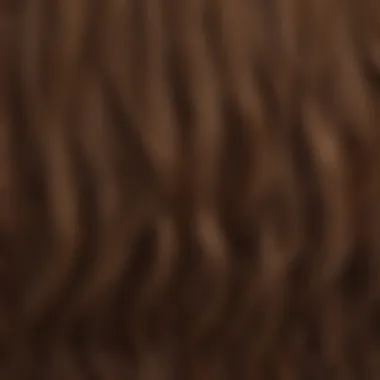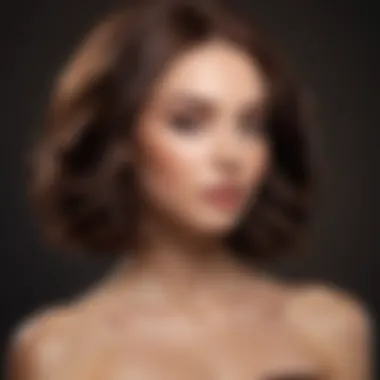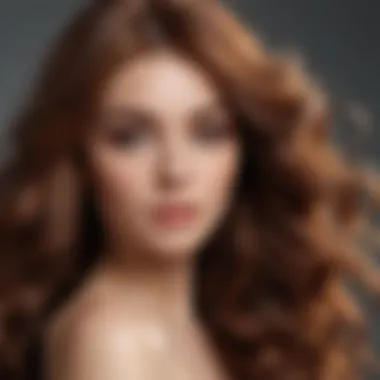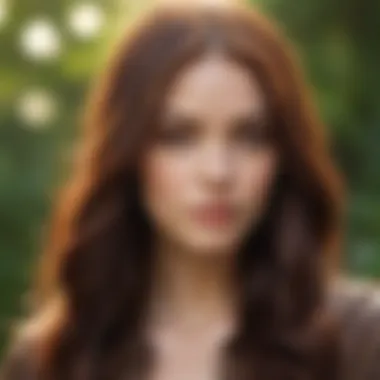Exploring the Spectrum of Brown Hair Colors


Intro
Brown hair is not just a single color; it is a complex spectrum that ranges from the softest light brown to the deepest, richest chocolate shades. This article aims to decode the various hues of brown hair, exploring their unique characteristics and implications for personal style. Understanding these shades can help women select a color that not only enhances their features but also aligns with current trends in fashion and beauty.
The diversity of brown hair colors reflects both individuality and cultural significance. From natural variations found in different ethnic backgrounds to the modern adaptations in beauty salons, brown hair offers numerous options for self-expression. Within this narrative, we will cover different aspects including fashion trends, beauty tips, and product recommendations, creating a comprehensive guide for women looking to elevate their appearance with a new shade of brown.
Preamble to Brown Hair Colors
Brown hair represents a captivating spectrum that varies significantly in shades, tones, and dimensions. This diversity makes it a popular choice among individuals looking to express their identity and style. The importance of exploring brown hair colors lies in the understanding of how these shades can enhance personal appearance while reflecting various moods and preferences.
In this article, we will explore the distinct characteristics of brown hair colors. By examining the differences between light, medium, and dark brown shades, we offer valuable insights into how each tone can complement individual skin tones and features.
Why Brown Hair? It is often perceived as versatile, making it a favorite among women of all ages. The reasons for this appeal are numerous. Firstly, brown hair can range from the delicate tones of light brown to the rich depths of dark brown. This range provides options for every taste, whether one seeks a subtle change or a dramatic alteration.
Moreover, each shade carries unique attributes that can influence one's overall look. Light brown hair may present a warm and gentle demeanor, while dark brown can convey strength and elegance. Thus, understanding these differences allows for informed choices when considering hair color changes.
Another critical consideration is the role of brown hair colors in beauty trends. As styles evolve, so do perceptions of hair color. This article will delve into how brown tones fit into Beauty industry standards. By staying informed on current trends, individuals can make choices that not only reflect their style but also align with cultural beauty standards.
Above all, choosing the right shade of brown can significantly enhance one's self-image. It provides an opportunity for personal expression, allowing individuals to showcase their uniqueness. In summary, the exploration of brown hair colors is not just about aesthetics; it is a deeper commentary on identity, cultural significance, and self-care in the realm of beauty.
The Basics of Hair Color
Understanding the fundamentals of hair color is essential for anyone looking to explore the various shades of brown hair. By grasping how hair color is created and how it functions, individuals can choose a shade that enhances their natural beauty and compliments their features. Hair color goes beyond mere aesthetics; it represents identity, personal style, and can often reflect cultural backgrounds. When it comes to brown hair, knowing the specifics allows for informed choices that align with one’s desired image and maintenance preferences.
Understanding Hair Pigments
Hair color primarily results from pigments developed in the hair follicles. These pigments are known as melanin, and they exist in two forms: eumelanin and pheomelanin. Eumelanin comes in two varieties, offering either a brown or black appearance, while pheomelanin provides a yellow or reddish hue. The balance between these pigments determines the final hair color. For brown hair, eumelanin is predominant, influencing the depth and richness of the hue.
The level of pigmentation is influenced by genetic factors, which dictate how much melanin a person produces. Thus, the natural color of one’s hair can vary significantly within the brown spectrum.
How Hair Color Works
Hair color is not a simple product of pigmentation; it involves various biological and environmental factors. The initial color of the hair is determined during the individual's development, but it can change over time, often due to aging, exposure to sunlight, and external chemical processes.
When discussing hair color, it’s important to consider both the natural hair color and any artificial color applications. Professional hair dyes contain different oxidative agents and colors that interact with the hair’s natural pigments, creating diverse shades. Understanding the interaction of these elements can aid consumers in selecting the right products for their hair goals.
"The interplay of natural pigments and artificial applications defines the beauty of hair color choices."
A good grasp of how hair color functions allows individuals to maintain their colored hair effectively, incorporating the appropriate products and treatments as necessary. This awareness can enhance the vibrancy of brown hair shades and improve their overall condition, ensuring they remain healthy and lustrous.
Categories of Brown Hair Color
Understanding the categories of brown hair color is essential for anyone looking to enhance their appearance. Brown hair is not a single shade; it encompasses a range of tones from light to dark. Each category offers unique features and maintenance needs, influencing personal style and how one is perceived. By exploring these variations, individuals can better choose a shade that complements their skin tone, enhances their features, and aligns with their lifestyle. The sections below break down the primary categories of brown hair: light, medium, and dark, detailing their characteristics and styling options.
Light Brown Hair
Characteristics of Light Brown Hair
Light brown hair serves as a versatile base shade that bridges the gap between blonde and darker browns. It often carries warm hues, which can impart an illuminating quality to the hair. A key characteristic of light brown hair is its soft, natural tone; this allows it to blend seamlessly with highlights and other color variations. This shade is particularly beneficial for those who desire a more understated color while retaining a touch of warmth. However, its lighter pigment can mean more frequent maintenance to avoid dullness and washout.
Styling Tips for Light Brown Hair
When working with light brown hair, styling options are abundant. Utilizing soft waves or curls can enhance the natural shine and dimension of the hair. Furthermore, light brown hair adapts well to both warmer and cooler highlights, making it a popular choice for subtle color contrasts. A significant styling tip is to experiment with varying partings; a side part can provide added volume and texture, while a middle part offers a sleek look. Be cautious with overly harsh colors, as they can clash with light brown, making careful selection paramount.


Medium Brown Hair
Defining Medium Brown Shades
Medium brown presents a balanced midway option. This shade typically embodies a richness that neither appears too light nor too dark. The key feature of medium brown shades is their depth, making them suitable for various skin tones. This category is beneficial as it requires less maintenance than light shades while providing a more vibrant look than darker hues. Individuals can find themselves in the sweet spot between easy upkeep and striking appearance.
Incorporating Color Variations
Incorporating color variations with medium brown hair can be both fun and rewarding. Highlighting techniques can introduce subtle lightness, while lowlights can enhance depth. A unique feature of this approach is it allows for personalized expression through different shades and textures. Medium brown hair readily accommodates these changes, ensuring that any adjustments remain harmonious with the base color. However, care must be taken to balance tones; overly drastic shifts may result in a fragmented look.
Dark Brown Hair
Distinct Features of Dark Brown Hair
Dark brown hair encompasses deep, rich tones often associated with elegance and sophistication. One of its defining characteristics is the luxurious sheen it can display when well cared for. This shade is popular as it flatters a wide range of skin tones and can create striking contrasts against lighter features. The dense pigment can also help mask damage or imperfections, making it a low-maintenance option for many.
Maintenance for Dark Brown Tones
While dark brown hair may seem demanding, maintenance primarily revolves around preserving its luster. Regular conditioning treatments can combat dryness, typical for darker shades. Choosing shampoos designed for colored hair can help maintain vibrancy. A unique feature of dark brown maintenance is to focus on hydrating products that enhance the color, preventing it from fading into a dull appearance. Knowing when to seek professional help for severe damage is crucial, as this can keep the hair looking healthy and vibrant.
Tonal Variations within Brown Hair
Understanding tonal variations within brown hair is essential for anyone looking to enhance their appearance or adapt their style. The distinction between cool and warm tones not only affects the aesthetic value of hair but also plays a significant role in how individuals resonate with their overall look. By identifying and utilizing these tonal variations, one can ultimately achieve a more personalized and flattering style.
Cool Brown Hair
Features of Cool Brown Hair
Cool brown hair is characterized by its ashy or neutral undertones. This type of brown often leans towards gray, with hints of blue or green. Cool brown shades can create a sleek and modern appearance, making them an attractive option for many women. One key characteristic of cool brown hair is how it tends to complement cooler skin tones, enhancing the natural complexion. Women with cool brown hair may find this tone is versatile and can shift seamlessly between various styles and cuts.
However, one needs to be cautious with cool tones, as they can sometimes appear flat if not styled correctly. The distinct advantage of cool brown hair is its ability to look polished and sophisticated without much effort.
Best Styles for Cool Undertones
When it comes to styles that work best for cool undertones, sleek and structured looks tend to shine. Straightened hair paired with a sleek bob or lob frames the face beautifully. In addition, longer styles that incorporate subtle waves add depth while maintaining the cool aspect of the color. The preference for cool undertones is popular because it can make the hair appear healthier and shinier.
Color techniques, such as balayage with cool highlights, also work effectively with this hair color. The unique feature of these styles is that they create dimension without overwhelming the natural tone of the hair. Despite their sophisticated appearance, some may find these styles maintenance-intensive, requiring regular touch-ups to sustain vibrancy.
Warm Brown Hair
Identifying Warm Brown Tones
Warm brown tones are defined by their richness, often featuring golden or honey undertones. Identifying these tones is crucial, as they can significantly influence a person's overall appearance. Warm brown shades tend to bring warmth to the skin tone, often making individuals appear more radiant. A key characteristic of warm brown hair is how it flatters those with warm skin tones. This makes it a popular choice among women seeking a more inviting look.
However, the downside can be that these tones may require more effort to maintain. The advantage of warm brown, though, is its ability to provide a lively and vibrant appearance, especially in sunlight.
Styling for Warm Undertones
When styling warm brown hair, the aim is to enhance the vibrancy without overpowering the natural beauty of the shade. Styles that incorporate layers work particularly well, as they create movement and dimension. Curls and waves can accentuate the warmed-up tones, providing a lively look. Many women appreciate these styles because they feel they embody warmth and approachability.
The warmer brown tones can often allow for more playful color additions, such as caramel highlights. These highlights bring in textures that complement the overall look. However, maintaining these colors can be a commitment. Regular treatments might be necessary to avoid fading, which some might find challenging.
Understanding the variation in brown hair tones lets individuals choose the best look tailored for their personal style.
The Role of Highlights and Lowlights


Highlights and lowlights play a significant role in elevating brown hair colors. They introduce depth and dimension, making the overall look more vibrant and multi-dimensional. Using these techniques, hair can appear fuller and more textured, which is especially beneficial for those with naturally flat or dull brown hair. Incorporating highlights and lowlights allows for a personalized approach to hair color, reflecting individual style and personality.
Additionally, highlights and lowlights can enhance the chosen shade of brown hair. For example, light brown with warm caramel highlights can create a sun-kissed effect, while dark brown with ashy lowlights adds sophistication. Furthermore, these techniques suit various hair types and lengths, making them a versatile choice for many individuals.
Adding Dimension with Highlights
Highlights add brightness and contrast to brown hair. They can invigorate a look and create visual interest. By strategically placing lighter shades, the hair's movement can be accentuated, resulting in a more dynamic appearance.
Types of Highlights for Brown Hair
There are several types of highlights suitable for brown hair. Balayage offers a soft, natural gradient effect. This method involves hand-painting sections of hair, allowing for a seamless transition between shades. Another popular technique is foil highlights, which provides more defined lines. This option is favored for its versatility and the ability to achieve both subtle and dramatic effects.
The key characteristic of highlights is their ability to brighten and freshen the overall appearance. They are a beneficial addition to anyone looking to enhance their brown hair, adding depth without requiring a dramatic color change. However, highlights can demand maintenance to keep them looking their best.
Application Techniques
Application techniques for highlights are crucial for achieving the desired look. The two main methods are foiling and balayage. Foiling involves wrapping sections of hair in aluminum foil, ensuring even processing. This technique allows for a concentrated color that pops against the base color.
Balayage, in contrast, is less controlled and focuses on a more organic look. The stylist applies color freehand, resulting in soft, sun-kissed highlights. Both techniques have their advantages. Foil highlights can last longer than balayage, while balayage can offer a more low-maintenance option as roots grow in.
Enhancing Depth with Lowlights
Lowlights serve to create shadowing effects in brown hair, giving it depth and richness. By adding darker strands, the hair can look fuller and more voluminous. This is especially effective for brown hair, which often falls into a singular shade without variation.
Choosing the Right Lowlight Shades
Selecting the right lowlight shades is essential for maintaining harmony in hair color. Opting for a shade that is one or two levels darker than the base color can successfully enhance depth without overwhelming the overall look. For instance, a medium brown with espresso lowlights creates a striking, yet sophisticated, appearance.
The unique feature of lowlights is their ability to complementary accentuate highlights. They help in softening the transition between colors and create a balance. However, choosing the wrong lowlight can lead to an undesirable effect, thus careful consideration is necessary.
Impact on Overall Hair Color
The impact of lowlights on overall hair color cannot be overstated. They provide contrast and visual intrigue, which can transform flat hair into a multi-faceted creation. The key characteristic here is the enhancement of the primary color, be it light or dark brown.
Due to their ability to define shape and texture, lowlights can enhance facial features significantly. While they can be perfect for creating a natural look, lowlights also require maintenance. If they fade too quickly, it can lead to an uneven appearance that requires professional attention.
In summary, highlights and lowlights are crucial in defining and enhancing brown hair colors. They contribute significantly to the visual dynamics of hair and can cater to personal style preferences.
Changing Perceptions of Brown Hair
Brown hair has historically been perceived through various lenses across cultures and eras. In the current beauty landscape, these perceptions are shifting. This section examines the factors influencing the changing views on brown hair. Today, brown hair is not merely considered a neutral color. It embodies a diverse palette with the potential for unique expression. The importance of understanding these shifts lies in empowering women who choose brown as their focal color, either as a natural trait or through dyeing.
Brown Hair in Fashion
Trends in Celebrity Styles
Celebrity influence plays a critical role in shaping fashion trends, including hair color choices. In recent years, many celebrities have embraced their brown hair, showcasing rich variations from chestnut to espresso. Stars like Emma Stone and Gigi Hadid frequently promote their effortless brown locks. These public figures highlight the advantages of brown, such as its versatility and ability to complement a range of skin tones. It also supports the idea that brown hair can be both sophisticated and casual. This trend encourages individuals to experiment with different shades and styles within the brown spectrum, illustrating its adaptability.
"Brown hair reflects a natural beauty that resonates with many, increasing its appeal."
Influence on Runway Looks
The runway also showcases the evolving perception of brown hair. Designers are increasingly opting for models with brown shades in their collections. This choice is often seen as a commitment to diversity and representation, recognizing the beauty of various hair colors. Brown tones have been featured prominently in high-fashion shows, with designers emphasizing styles that enhance the warmth of these shades. The unique feature of this trend is its alignment with natural beauty, elevating simplicity over artificiality. This advantage resonates with audiences seeking authenticity in beauty.


Cultural Significance of Brown Hair
Brown Hair Across Cultures
Globally, brown hair is viewed in distinct ways depending on cultural context. In some societies, it symbolizes humility and approachability, while in others, it might be associated with nobility. Understanding these diverse perceptions can enrich one's appreciation for brown hair. For instance, in certain European cultures, dark brown hair may mark someone as intellectual. This diverse perception broadens the scope of how brown hair is embraced. Recognizing these cultural insights offers women a valuable perspective on their choices regarding hair color.
Societal Attitudes Towards Brown Shades
Societal attitudes toward brown hair are evolving, reflecting broader changes in beauty standards. Historically, blonde or red hair often dominated popular culture, sometimes overshadowing brown shades. However, the modern narrative emphasizes celebrating all colors. Brown hair is increasingly regarded as chic and fashionable, partly driven by the rising trend in embracing individuality. This shift validates personal choices in hair color, encouraging women to feel confident in their beauty. By shedding outdated views and recognizing the beauty in brown shades, society fosters a more inclusive environment.
Self-Care and Maintenance
Self-care and maintenance are essential components in preserving the vibrancy and health of brown hair. Given the many shades and tones of brown hair, each can exhibit unique needs. Proper care ensures that the hair retains its luster and remains manageable. By understanding and implementing specific self-care practices, individuals can enhance their hairstyle's overall appearance and health.
Essential Care for Brown Hair
Shampooing and Conditioning Routines
Shampooing and conditioning routines are vital for maintaining the integrity of brown hair. Regular shampooing removes dirt and excess oils from the scalp and hair. Choosing the right shampoo is crucial; sulfate-free options are often recommended as they are less harsh and gentle on color-treated hair. Conditioning, on the other hand, provides moisture and helps detangle hair, which is especially important for maintaining fluid styles.
A well-structured routine can significantly contribute to the shine and softness of brown hair. For example, using a color-safe conditioner can protect the hue from fading, thus allowing the natural richness of the brown shades to shine. However, over-conditioning can lead to buildup, so balancing these products is important for ultimate health.
Products Tailored for Brown Hair
Selecting products specifically formulated for brown hair adds another level of care. These products often contain ingredients that enhance shine and combat dullness, common issues for brown hair varieties. A clarifying shampoo, for instance, can invigorate the hair by removing buildup that regular shampoo might miss.
Additionally, color-depositing shampoos and conditioners can deepen or brighten brown shades. Such products can bring out subtle tones in the hair while keeping color maintained. They are especially advantageous for those who wish to experiment with different looks without harsh chemical treatments.
When to Seek Professional Help
Signs of Damage
Recognizing the signs of damage in brown hair is key to appropriate maintenance. Dullness, excessive breakage, and split ends signal that hair is not healthy. Individuals should pay attention to these indicators and seek help when they experience unmanageable dryness or texture loss.
Understanding when hair is damaged can prevent further issues, which might require more intensive treatments. In some cases, untreated damage can lead to hair loss, highlighting the importance of keen awareness and proactive care.
Understanding Professional Treatments
Grasping the options available for professional treatments is crucial for anyone looking to enhance or restore their brown hair. Treatments such as deep conditioning, keratin treatments, and trims can rejuvenate locks needing extra care. These options often utilize advanced products and techniques that are not accessible in standard home care regimens.
Each treatment offers distinct benefits. For example, deep conditioning can add hydration and restore softness to hair that has become brittle. It is often a popular choice among individuals who regularly color their hair, as it helps to mitigate the impact of chemicals used in dyes.
It is essential to discuss expectations with professionals to tailor treatments to specific needs. Understanding what each professional service entails can contribute to informed decisions and ultimately healthier, more vibrant hair.
Ending
In summation, understanding the spectrum of brown hair colors is crucial for anyone looking to enhance their natural beauty. The various shades, from light to dark, and the associated nuances carry specific characteristics that can affect an individual's overall appearance and style. Knowing these elements allows women to make informed decisions about their hair color choices.
Brown hair is not merely a single category but a collection of tones and variations. The effects of color can range from providing warmth to creating depth or even highlighting features.
Significance of Brown Hair Colors
- Contemporary Relevance: The versatility of brown hair colors seamlessly fits into ongoing trends within the fashion and beauty industry.
- Personal Identity: Hair color often serves as a form of self-expression. A shade may connect with personal taste or even cultural identity.
Additionally, the maintenance required for different shades is an important consideration. Different products can enhance or undermine the vibrancy of the color. For example, those with dark brown hair might require specific shampoos to keep their color from looking dull over time.
"Understanding the intricate dynamics of hair color categories can significantly empower your styling choices."
Final Thoughts
Ultimately, the exploration of brown hair colors is not just about aesthetics but also about personal choice, identity, and cultural trends. This article has aimed to equip readers with valuable insights on how to navigate the rich diversity of brown shades. By knowing the implications of each shade, one can achieve not only a desirable look but also bolster confidence in one's appearance.



